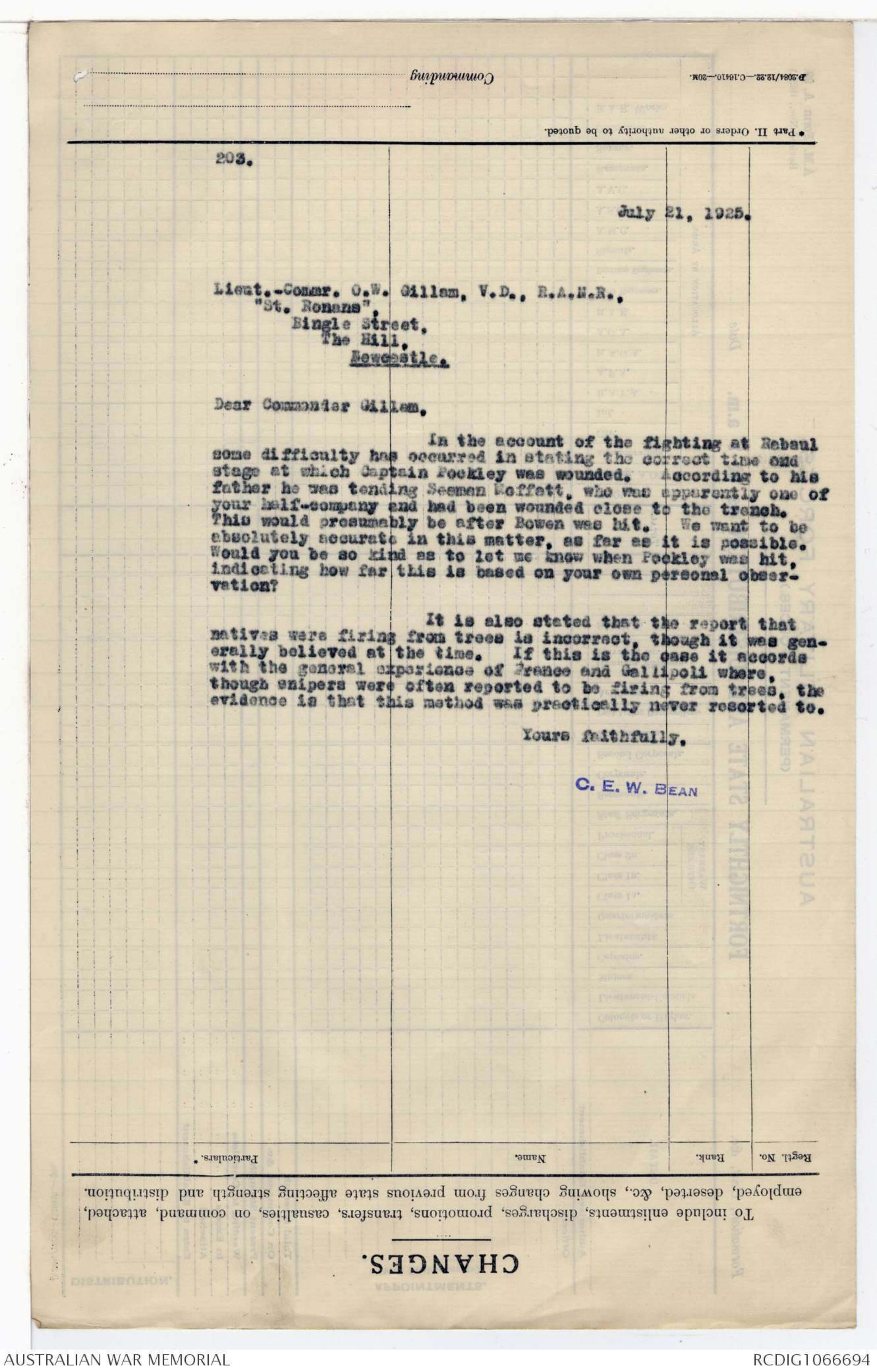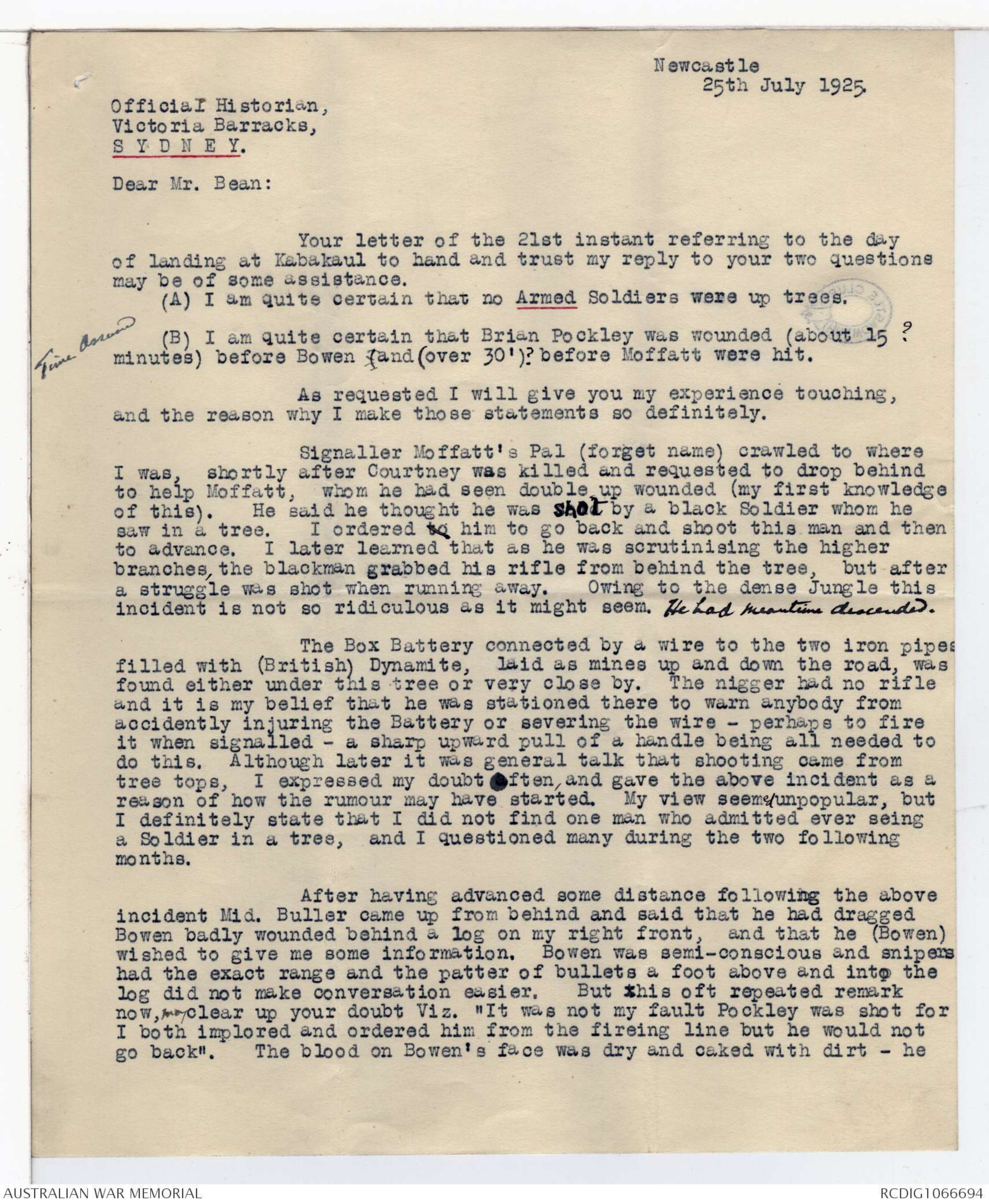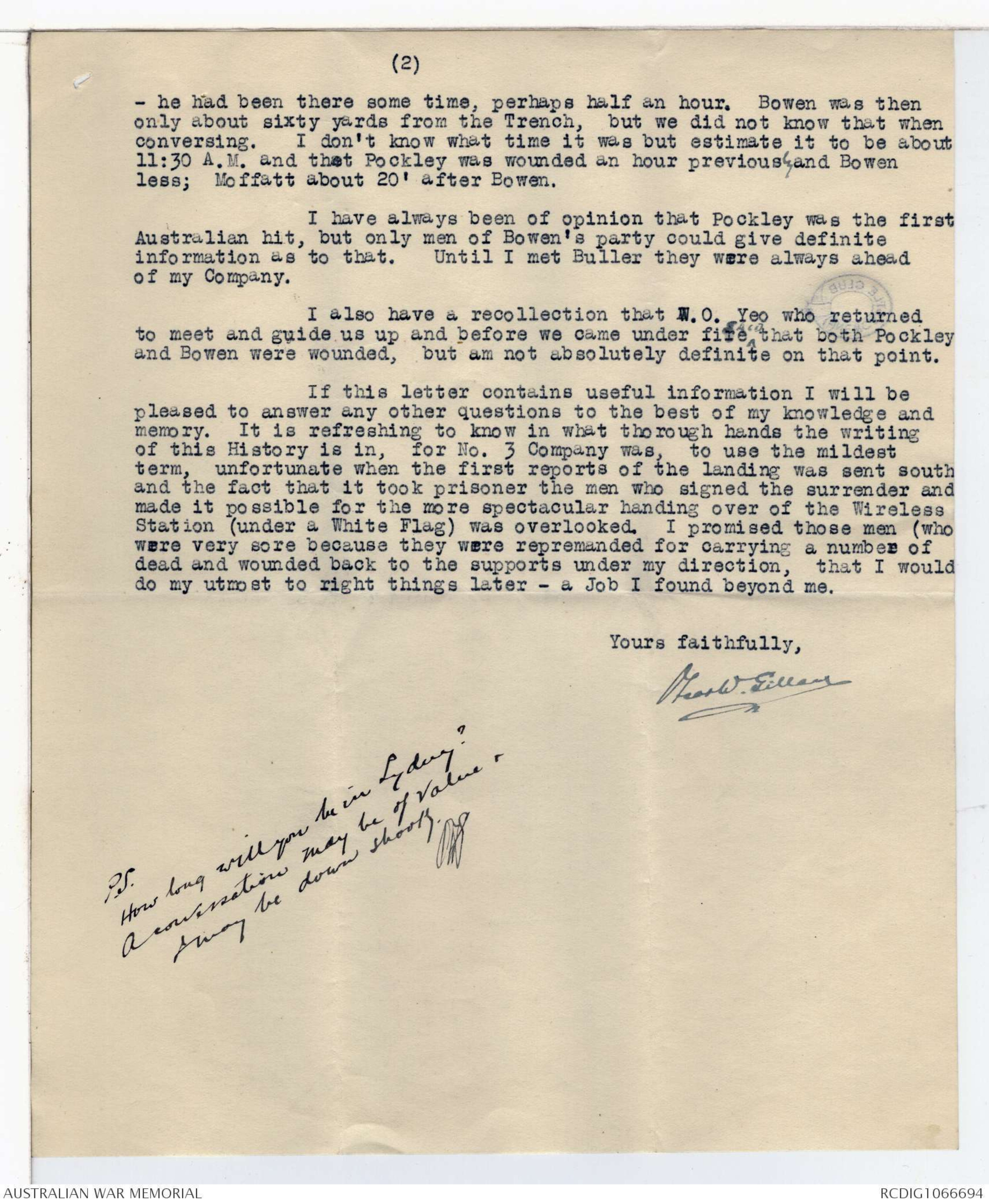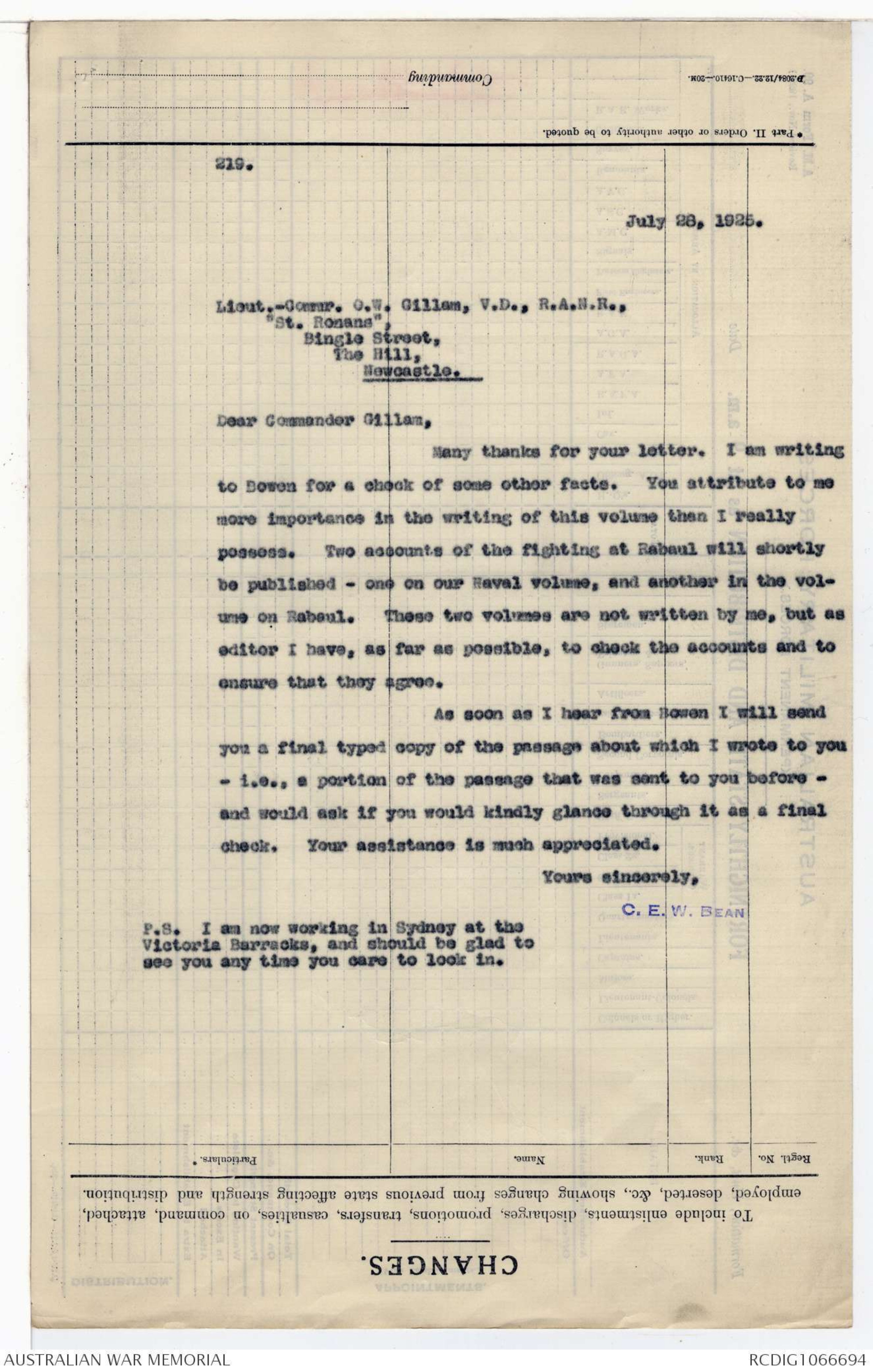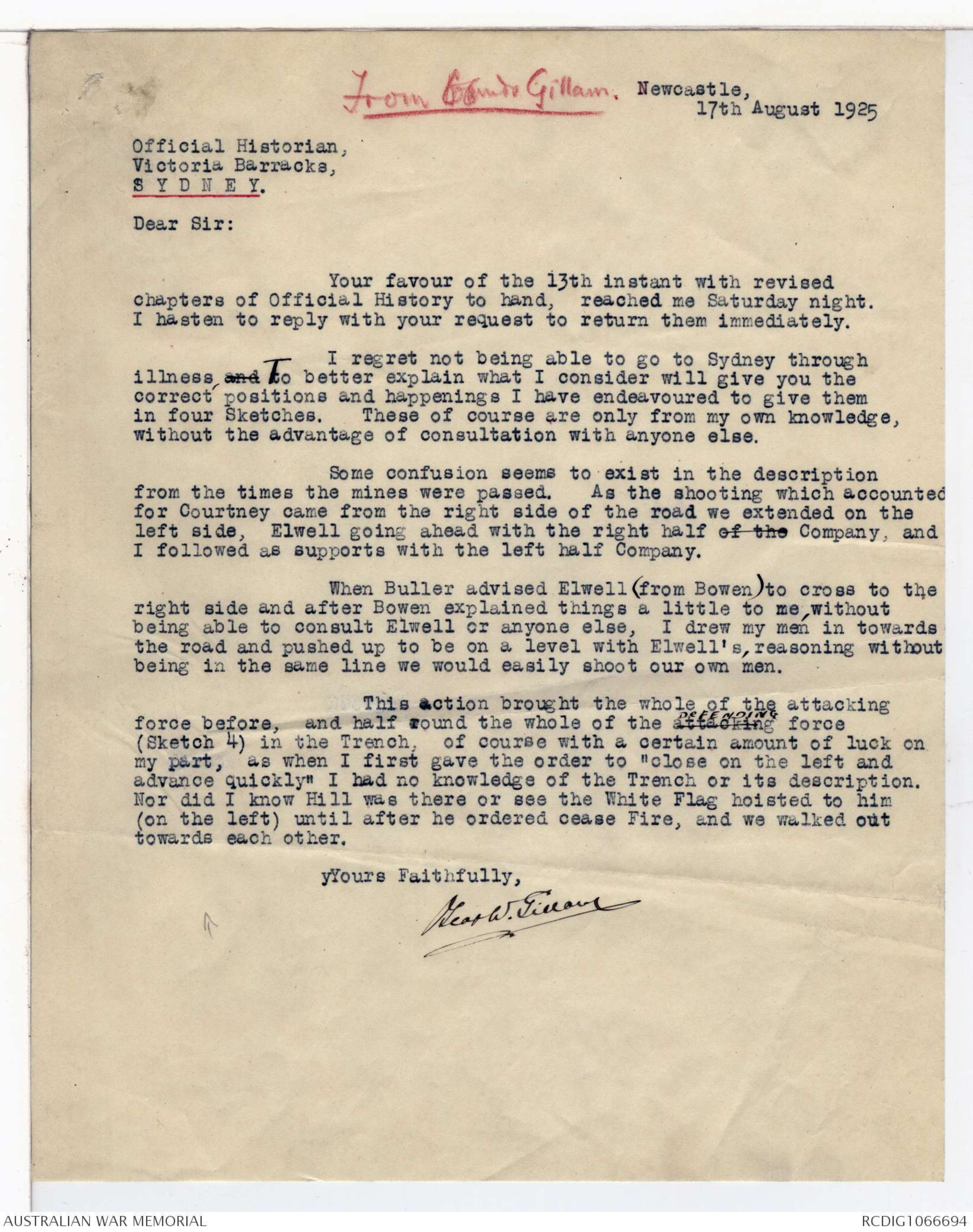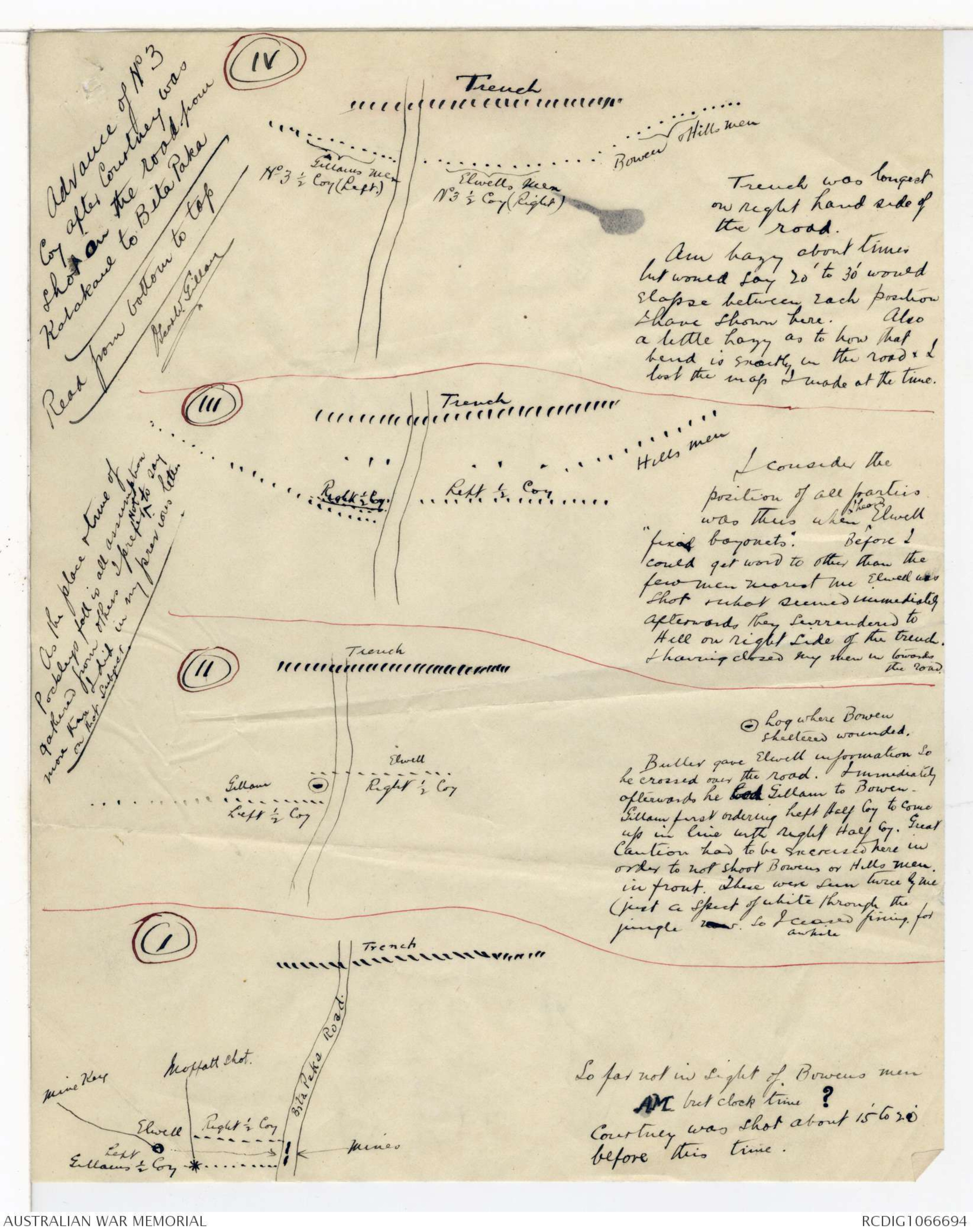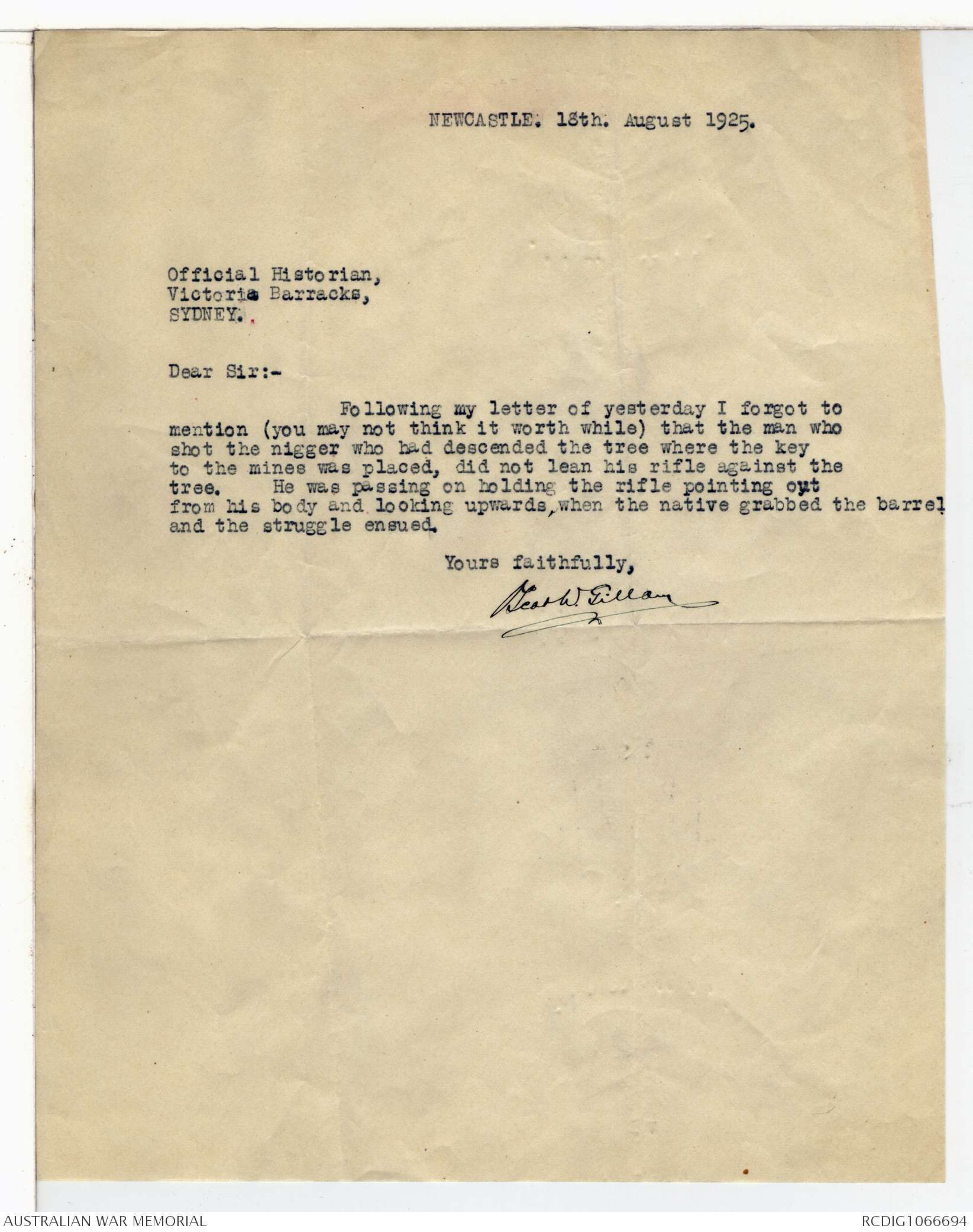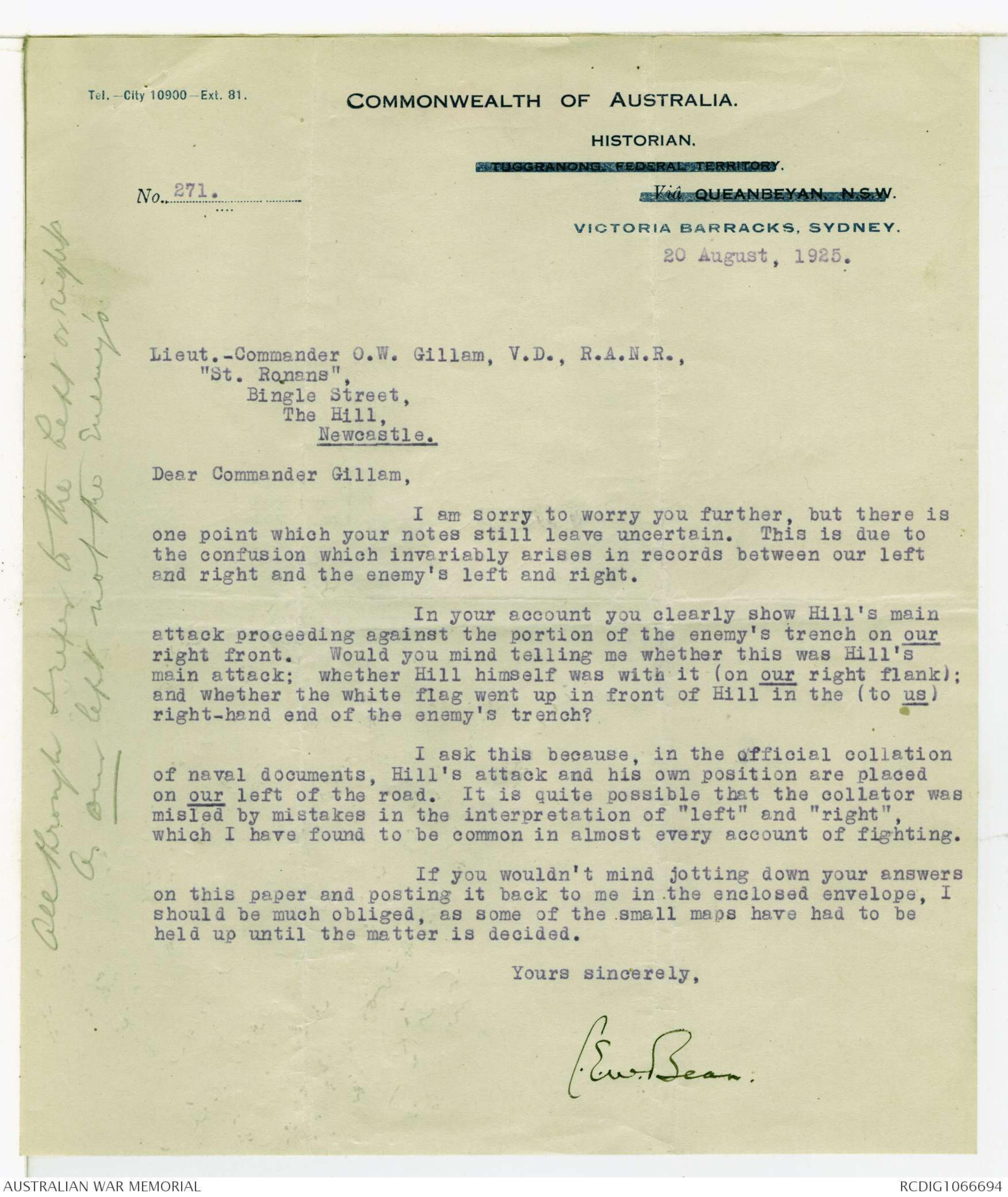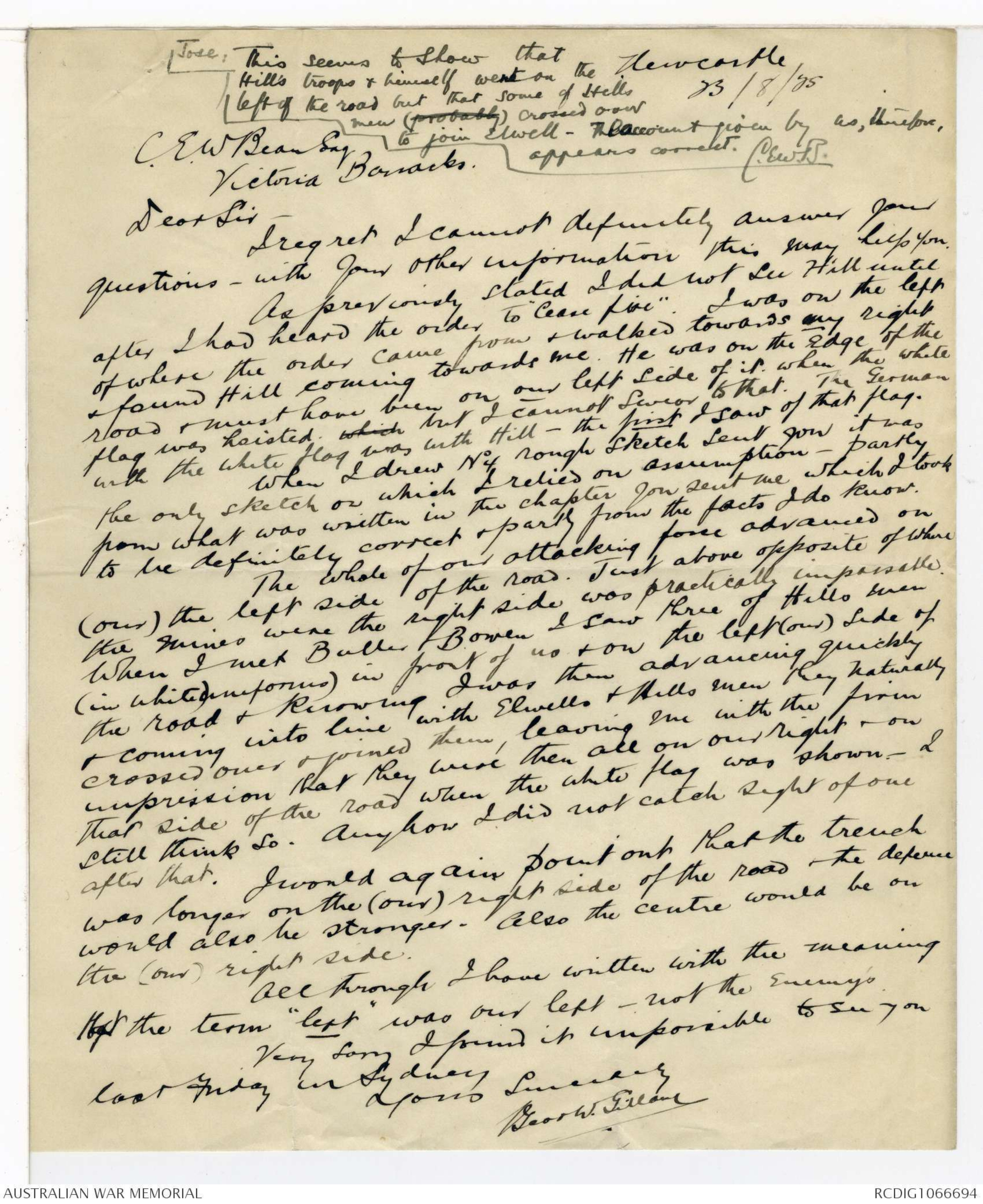Charles E W Bean, Diaries, AWM38 3DRL 606/258/1 - 1914 - 1927 - Part 3
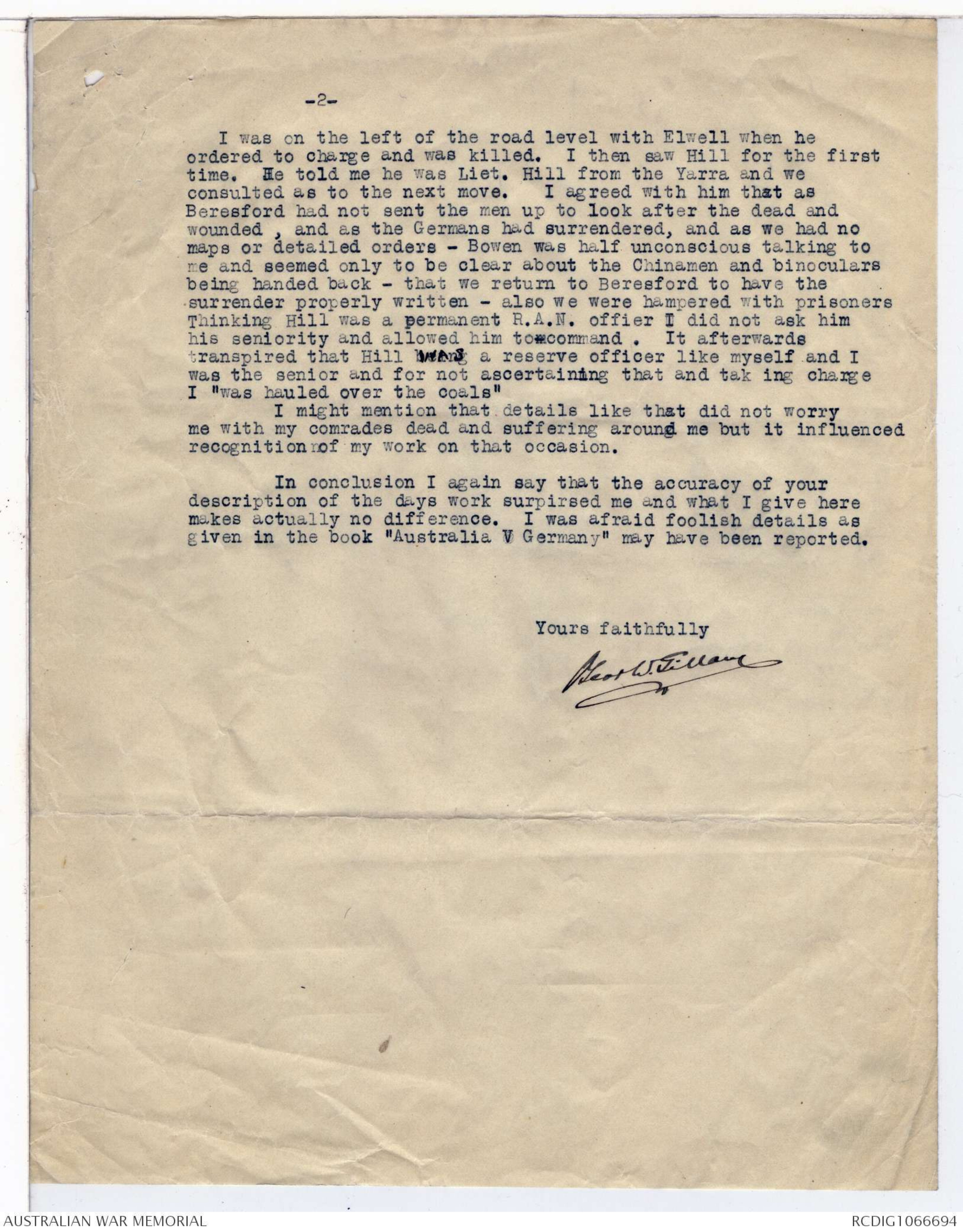
-2-
I was on the left of the road level with Elwell when he
ordered to charge and was killed. I then saw Hill for the first
time. He told me he was Liet. Hill from the Yarra and we
consulted as to the next move. I agreed with him that as
Beresford had not sent the men up to look after the dead and
wounded, and as the Germans had surrendered, and as we had no
maps or detailed orders - Bowen was half unconscious talking to
me and seemed only to be clear about the Chinamen and binoculars
being handed back - that we return to Beresford to have the
surrender properly written - also we were hampered with prisoners
Thinking Hill was a permanent R.A.N. officer I did not ask him
his seniority and allowed him to command. It afterwards
transpired that Hill being a reserve officer like myself and I
was the senior and for not ascertaining that and taking charge
I "was hauled over the coals".
I might mention that details like that did not worry
me with my comrades dead and suffering around me but it influenced
recognition of my work on that occasion.
In conclusion I again say that the accuracy of your
description of the days work surprised me and what I give here
makes actually no difference. I was afraid foolish details as
given in the book " Australia V Germany" may have been reported.
Yours faithfully
Geo W Gillam
203.
July 21, 1925.
Lieut. -Commr. G.W. Gillam, V.D., R.A.N.R.,
"St. Ronans",
Bingle Street,
The Hill,
Newcastle.
Dear Commander Gillam,
In the account of the fighting at Rabaul
some difficulty has occurred in stating the correct time and
stage at which Captain Pockley was wounded. According to his
father he was tending Seaman Moffatt, who was apparently one of
your half-company and had been wounded close to the trench.
This would presumably be after Bowen was hit. We want to be
absolutely accurate in this matter, as far as it is possible.
Would you be so kind as to let me know when Pockley was hit,
indicating how far this is based on your own personal observation?
It is also stated that the report that
natives were firing from trees is incorrect, though it was generally
believed at the time. If this is the case it accords
with the general experience of France and Gallipoli where,
though snipers were often reported to be firing from trees, the
evidence is that this method was practically never resorted to.
Yours faithfully,
C.E.W. BEAN
Newcastle
25th July 1925.
Official Historian,
Victoria Barracks,
SYDNEY.
Dear Mr. Bean:
Your letter of the 21st instant referring to the day
of landing at Kabakaul to hand and trust my reply to your two questions
may be of some assistance.
(A) I am quite certain that no Armed Soldiers were up trees.
(B) I am quite certain that Brian Pockley was wounded (about 15?
minutes) before Bowen and (over 30')? before Moffatt were hit.
As requested I will give you my experience touching,
and the reason why I make those statements so definitely.
Signaller Moffatt's Pal (forget name) crawled to where
I was, shortly after Courtney was killed and requested to drop behind
to help Moffatt, whom he had seen double up wounded (my first knowledge
of this). He said he thought he was shot by a black Soldier whom he
saw in a tree. I ordered to him to go back and shoot this man and then
to advance. I later learned that as he was scrutinising the higher
branches, the blackman grabbed his rifle from behind the tree, but after
a struggle was shot when running away. Owing to the dense Jungle this
incident is not so ridiculous as it might seem. He had meantime descended.
The Box Battery connected by a wire to the two iron pipes
filled with (British) Dynamite, laid as mines up and down the road, was
found either under this tree or very close by. The nigger had no rifle
and it is my belief that he was stationed there to warn anybody from
accidently injuring the Battery or severing the wire - perhaps to fire
it when signalled - a s harp upward pull of a handle being all needed to
do this. Although later it was general talk that shooting came from
tree tops, I expressed my doubt often, and gave the above incident as a
reason of how the rumour may have started. My view seems unpopular, but I
definitely state that I did not find one man who admitted ever seeing
a Soldier in a tree, and I questioned many during the two following
months.
After having advanced some distance following the above
incident Mid.Buller came up from behind and said that he had dragged
Bowen badly wounded behind a log on my right front, and that he (Bowen)
wished to give me some information. Bowen was sem-conscious and snipers
had the exact range and the patter of bullets a foot above and into the
log did not make conversation easier. But this oft repeated remark
now, may clear up your doubt Viz. "It was not my fault Pockley was shot for
I both implored and ordered him from the fireing line but he would not
go back". The blood on Bowen's face was dry and caked with dirt - he
(2)
-he had been there some time, perhaps half an hour. Bowen was then
only about sixty yards from the Trench, but we did not know that when
conversing. I don't know what time it was but estimate it to be about
11:30 A.M. and that Pockley was wounded an hour previously and Bowen
less; Moffatt about 20' after Bowen.
I have always been of opinion that Pockley was the first
Australian hit, but only men of Bowen's party could give definite
information as to that. Until I met Buller they were always ahead
of my Company.
I also have a recollection that W.O.Yeo who returned
to meet and guide us up and before we came under fire ^said that both Pockley
and Bowen were wounded, but am not absolutely definite on that point.
If this letter contains useful information I will be
pleased to answer any other questions to the best of my knowledge and
memory. It is refreshing to know in what thorough hands the writing
of this History is in, for No. 3 Company was, to use the mildest
term, unfortunate when the first reports of the landing was sent south
and the fact that it took prisoner the men who signed the surrender and
made it possible for the more spectacular handing over of the Wireless
Station (under a White Flag) was overlooked. I promised those men (who
were very sore because they were repremanded for carrying a number of
dead and wounded back to the supports under my direction, that I would
do my utmost to right things later - a Job I found beyond me.
Yours faithfully,
Geo. W. Gillam
P.S.
How long will you be in Sydney?
A conversation may be of value &
I may be down shortly.
219.
July 28, 1925.
Lieut.-Commr. G.W.Gillam, V.D., R.A.N.R.,
"St Ronans",
Bingle Street,
The Hill,
Newcastle.
Dear Commander Gillam,
Many thanks for your letter. I am writing
to Bowen for a check of some other facts. You attribute to me
more importance in the writing of this volume than I really
possess. Two accounts of the fighting at Rabaul will shortly
be published - one on our Haval volume, and another in the volume
on Rabaul. These two volumes are not written by me, but as
editor I have, as far as possible, to check the accounts and to
ensure that they agree.
As soon as I hear from Bowen I will send
you a final typed copy of the passage about which I wrote to you
-i.e., a portion of the passage that was sent to you before -
and would ask if you would kindly glance through it as a final
check. Your assistance is much appreciated.
Yours sincerely,
C.E.W.BEAN
P.S. I am now working in Sydney at the
Victoria Barracks, and should be glad to
see you any time you care to look in.
From Comdr Gillam.
Newcastle,
17th August 1925
Official Historian,
Victoria Barracks,
SYDNEY.
Dear Sir:
Your favour of the 13th instant with revised
chapters of Official History to hand, reached me Saturday night.
I hasten to reply with your request to return them immediately.
I regret not being able to go to Sydney through
illness, and To better explain what I consider will give you the
correct positions and happenings I have endeavoured to give them
in four Sketches. These of course are only from my own knowledge,
without the advantage of consultation with anyone else.
Some confusion seems to exist in the description
from the times the mines were passed. As the shooting which accounted
for Courtney came from the right side of the road we extended on the
left side, Elwell going ahead with the right half of the Company, and I
followed as supports with the left half Company.
When Buller advised Elwell (from Bowen) to cross to the
right side and after Bowen explained things a little to me, without
being able to consult Elwell or anyone else, I drew my men in towards
the road an pushed up to be on a level with Elwell's reasoning without
being in the same line we would easily shoot our own men.
This action brought the whole of the attacking
force before, and half round the whole of the attacking DEFENDING force
(Sketch 4) in the Trench, of course with a certain amount of luck on
my part, as when I first gave the order to "close on the left and
advance quickly" I had no knowledge of the Trench or its description.
Nor did I know Hill was there or see the White Flag hoisted to him
(on the left) until after he ordered cease Fire, and we walked out
towards each other.
Yours faithfully
Geo W.Gillam
(IV)
Diagram - See original document
Trench
Geo. W. Gillam
Trench was longest on right hand side of the road.
Am hazy about times but would say 20' to 30' would
elapse between each position I have shown here. Also
a little hazy as to how that bend is [shortly?] in the road & I
lost the map I made at the time.
(III) Trench
Diagram - See original document
As the place & time of
Pockleys foll is all assumption
gathered from others I prefer ^ not to say
more than I did in my previous letter on that subject.
I consider the position of all parties
was thus when ^I heard Elwell "fixed bayonets".
Before I could get word to other than the few
men nearest me Elwell was shot & what seemed
immediately afterwards they surrendered to
Hill on right side of the trench. I having closed my men
in towards the road.
(II)Trench
Diagram - See original document
(-) Log where Bowen sheltered wounded.
Buller gave Elwell information so he crossed
over the road. Immediately afterwards he
led Gillam to Bowen. Gillam first ordering left
half Coy to come up in line with right half Coy. Great
caution had to be exercised here in order to not
shoot Bowens or Hills men in front. These were seen twice
by me (just a speck of white through the jungle. now
So I ceased firing for awhile.
(I) Trench
Diagram - See original document
So far not in sight of Bowens men
AM but clock time?
Courtney was shot about 15' to 20'
before this time.
NEWCASTLE. 18th. August 1925.
Official Historian,
Victoria Barracks,
SYDNEY.
Dear Sir:-
Following my letter of yesterday I forgot to
mention (you may not think it worth while) that the man who
shot the nigger who had descended the tree where the key
to the mines was placed, did not lean his rifle against the
tree. He was passing on holding the rile pointing out
from his body and looking upwards, when the native grabbed the barrel
and the struggle ensued.
Yours faithfully,
Geo W.Gillam
Tel. - City 10900 - Ext. 81.
COMMONWEALTH OF AUSTRALIA.
HISTORIAN.
TUGGRANONS. FEDERAL TERRITORY.
VIA QUEANBEYAN N.S.W.
No. 271.
VICTORIA BARRACKS, SYDNEY.
20 August, 1925.
Lieut.-Commander O.W.Gillam, V.D., R.A.N.R.,
"St. Ronans".
Bingle Street,
The Hill,
Newcastle.
Dear Commander Gillam,
I am sorry to worry you further, but there is
one point which your notes still leave uncertain. This is due to
the confusion which invariably arises in records between our left
and right and the enemy's left and right.
In your account you clearly show Hill's main
attack proceeding against the portion of the enemy's trench on our
right front. Would you mind telling me whether this was Hill's
main attack: whether Hill himself was with it (on our right flank);
and whether the white flag went up in front of Hill in the (to us)
right-hand end of the enemy's trench?
I ask this because, in the official collation
of naval documents, Hill's attack and his own position are placed
on our left of the road. It is quite possible that the collator was
misled by mistakes in the interpretation of "left" and "right",
which I have found to be common in almost every account of fighting.
If you wouldn't mind jotting down your answers
on this paper and posting it back to me in the enclosed envelope, I
should be much obliged, as some of the small maps have had to be
held up until the matter is decided.
Yours sincerely
C.E.W.Bean.
[*All through I refer to the left or right as our left not the enemy's*.]
[*[Jose: This seems to show that
Hill's troops & himself went on the
left of the road but that some of Hells
men (probably) crossed over
to join Elwell - The account given by us, therefore,
appears correct. C.E.W.Bean]*]
Newcastle
23/8/25
C.E.W.Bean Esq
Victoria Barracks.
Dear Sir
I regret I cannot definitely answer your
questions - with your other information this may help you.
As previously stated I did not see Hill until
after I had heard the order to "Cease Fire". I was on the left
of where the order came from & walked towards my right
& found Hill coming towards me. He was on the edge of the
road & must have been on our left side of it when the white
flag was hoisted. which but I cannot swear to that. The German
flag with the white flag was with Hill - the first I saw of that flag.
When I drew No4 rough sketch sent you it was
the only sketch on which I relied on assumption - partly
from what was written in the chapter you sent me which I took
to be definitely correct & partly from the facts I do know.
The whole of our attacking force advanced on
(our) the left side of the road. Just above opposite of where
the mines were the right side was practically impossible.
When I met Buller & Bowen I saw three of Hills men
(in white uniforms) in front of us & on the left (our) side of
the road & knowing I was then advancing quickly
& coming into line with Elwells & Hills men they naturally
crossed over & joined them, leaving me with the firm
impression that they were then all on our right & on
that side of the road when the white flag was shown. I
still think so. Anyhow I did not catch sight of one
after that.
I would again point out that the trench
was longer on the (our) right side of the road & the defence
would also be stronger. Also the centre would be on
the (our) right side.
All through I have written with the meaning
that the term "left" was our left - not the enemy's
Very sorry I found it impossible to see you
last Friday in Sydney
Yours sincerely
Geo W Gillam
 Sam scott
Sam scottThis transcription item is now locked to you for editing. To release the lock either Save your changes or Cancel.
This lock will be automatically released after 60 minutes of inactivity.
